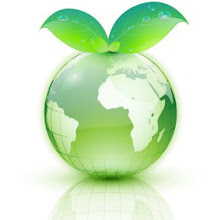 Global warming is the increase in the average temperature of Earth's near-surface air and oceans since the mid-20th century and its projected continuation. According to the 2007 Fourth Assessment Report by the Intergovernmental Panel on Climate Change (IPCC), global surface temperature increased 0.74 ± 0.18 °C (1.33 ± 0.32 °F) during the 20th century. Climate model projections summarized in the latest IPCC report indicate that the global surface temperature is likely to rise a further 1.1 to 6.4 °C (2.0 to 11.5 °F) during the 21st century.
Global warming is the increase in the average temperature of Earth's near-surface air and oceans since the mid-20th century and its projected continuation. According to the 2007 Fourth Assessment Report by the Intergovernmental Panel on Climate Change (IPCC), global surface temperature increased 0.74 ± 0.18 °C (1.33 ± 0.32 °F) during the 20th century. Climate model projections summarized in the latest IPCC report indicate that the global surface temperature is likely to rise a further 1.1 to 6.4 °C (2.0 to 11.5 °F) during the 21st century.Most of the observed temperature increase has been caused by increasing concentrations of greenhouse gases, which result from human activity such as the burning of fossil fuel and deforestation. Greenhouse gases (carbon dioxide, water vapor, nitrous oxide, and methane) trap heat and light from the sun in the earth’s atmosphere, which increases the temperature. If there gets to be too many gases, the earth can get unusually warmer, and many plants, animals, and people will die.
Another thing that causes global warming is electrical pollution. When fossil fuels are burned, many pollutants are sent into the air.
Some other examples of using energy and polluting the air are:
- Turning on a light
- Watching T.V.
- Listening to a stereo
- Washing or drying clothes
- Using a hair dryer
- Riding in a car
- Heating a meal in the microwave
- Using an air conditioner
- Using a dish washer
When we throw our garbage away, the garbage goes to landfills. The garbage is then sometimes burned. This sends an enormous amount of greenhouse gasses into the air and makes global warming worse. Another thing that makes global warming worse is when people cut down trees. Trees and other plants collect carbon dioxide (CO2), This gas, CO2, collects light and heat (radiant energy), produced by the sun, and this makes the earth warmer. Evidence for warming of the climate system includes observed increases in global average air and ocean temperatures, widespread melting of snow and ice, expansion of subtropical deserts, and rising global average sea level. Global warming is killing algae, also destroying many huge forests. Other likely effects include changes in the frequency and intensity of extreme weather events, species extinctions, and changes in agricultural yields.
One thing people are doing to stop global warming is carpooling. This minimizes the amount of greenhouse gases put into the air by a car. Another thing that people are doing is being more careful about leaving things turned on like the television, computer, and the lights. Now, more people are even riding buses, walking to school, and riding their bikes to lower the amount of greenhouse gases in the air. Planting trees and recycling also helps. As a result, less greenhouse gasses will rise into the air, and global warming will slow down.
Global dimming, a result of increasing concentrations of atmospheric aerosols that block sunlight from reaching the surface, has partially countered the effects of warming induced by greenhouse gases. These aerosols exert a cooling effect by increasing the reflection of incoming sunlight. Radioactive forcing due to aerosols is temporally limited due to wet deposition which causes aerosols to have an atmospheric lifetime of one week. Carbon dioxide has a lifetime of a century or more, and as such, changes in aerosol concentrations will only delay climate changes due to carbon dioxide.
The government made a law called The Clean Air Act which is making many companies changes their products to decrease global warming. Part of the law says that you may not put a certain amount of pollutants in the air. Making and using hairspray, foam cups etc let out too many volatile organic compounds (VOC’s), ozone-destroying chemicals (chlorofluorocarbons (CFC’s), and related chemicals (CO2) into the air. Now, almost all of these products have a label on them telling people what this product can do to the environment and many people.
Cars, buses, and trucks are also responsible for over 50% of dangerous chemicals let into the air. The Clean Air Act has also made car companies change some of the things inside of the cars. While cars make more than half of the world’s smog (visible pollution in the air), many things that cars need to move and heat up make even more pollution. Some things that are inside of cars, buses, trucks, and motorcycles, like gasoline, pollute the air when the fuel is burned. It comes out as a chemical and when mixed in the air, forms smog.
Global warming is one of the most serious challenges facing us today. To protect the health and economic well-being of current and future generations, each individual can bring an important help adopting a more responsible lifestyle: starting from little, everyday things. It's the only reasonable way to save our planet, before it is too late.



Three “Stop Global Warming” Campaign posters






0 comments:
Post a Comment